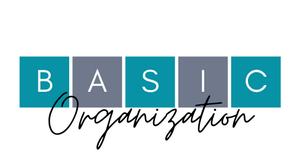“Kiss Your Clutter Goodbye”- Part 1
The Kiss Your Clutter Goodbye Series
This is the beginning of the “Kiss Your Clutter Goodbye” series. In the next 7 weeks, we’ll explore some organizing concepts that will help you declutter and maintain your newly organized spaces.
We all have stuff in our space that we don’t even notice until we think about getting organized. Then we start to question, “What is this?”, or “Why do I have it?”. Clutter slows you down and takes up space, so let’s start actively decluttering and see what happens!
Your first concept is to do an assessment of each space. It’s funny how we live in a space, but don’t often take the time to look at it. I mean really look at it. Stand in the middle of a room in your home and turn 360. What do you see that you didn’t see a moment ago?
Assess Each Room
Do some research in your own home. Move from room to room writing down what activities you use, or would like to use each space for. What’s the purpose of each space? Don’t forget to ask your family members. They may have different ideas than your own. Now you can focus on removing anything that doesn’t support the activities you want to do in each space. Get started by:
- Focusing on one room. Once you find success, then you can move on to the next space.
- Identifying zones in a room with many activities. With zones within rooms, everything should find a home.
- Sorting like items, then identify where that type of item will live.
It works because you will be setting priorities within your home. By writing down what you want and where you want it, you will communicate to the whole family your priorities. You will also be laying the foundation to maintain the organization you created.
We all have stuff in our space that we don’t even notice until we think about getting organized. Share on X
Clearing clutter is not “One Solution Fits All.” It can’t be done in one day. So, I decided to write a series of blogs to help you start thinking about how you can start to “Kiss Your Clutter Goodbye”. Follow along for different strategies to get rid of what is holding you back.
Subscribe by email
Enter your email address to subscribe to this blog and receive notifications of new posts by email.
Janet Schiesl

Janet has been organizing since 2005. She is a Certified Professional Organizer and the owner of Basic Organization.
She loves using her background as a space planner to challenge her clients to look at their space differently. She leads the team in large projects and works one-on-one with clients to help the process move quickly and comfortably. Call her crazy, but she loves to work with paper, to purge what is not needed and to create filing systems that work for each individual client.
Janet is a Past Board Member of the National Association of Productivity and Organizing Professionals and a Past President of the Washington DC Chapter of NAPO were she has been named Organizer of the Year and Volunteer of the Year.

Janet Schiesl
Janet has been organizing since 2005. She is a Certified Professional Organizer and the owner of Basic Organization.
She loves using her background as a space planner to challenge her clients to look at their space differently. She leads the team in large projects and works one-on-one with clients to help the process move quickly and comfortably. Call her crazy, but she loves to work with paper, to purge what is not needed and to create filing systems that work for each individual client.
Janet is a Past Board Member of the National Association of Productivity and Organizing Professionals and a Past President of the Washington DC Chapter of NAPO were she has been named Organizer of the Year and Volunteer of the Year.

I typically purge and declutter in January but it was such a busy month that i didn’t get around to it. Looking forward to this series since it’s perfect timing for me and sure to be full of helpful tips!
I’m glad the timing worked out! Good luck!
I love to have clients tell me the purpose of a room or area before we start to declutter it. I remember one client tell me this space was for her to do her schoolwork and for her child to do his schoolwork. Anything else? Oh, yes, I exercise here. Anything else? No. Then I say, “I can’t help but notice the ironing board is set up in here.”
We just don’t notice at time.
Having clarity of purpose can be so powerful when undertaking a decluttering project. Sometimes we do forget how we use the space and how to connect that to how we wish we used the space.
Deciding the purpose for a room and zones within is an excellent place to start. That objective or “why” can help with motivation to declutter and organize the space to support your needs. And with that win, it will be easier be motivated to continue to the next space.
Yes, you need the ‘why’! Always need a ‘why’.
This will be a fun series. I look forward to all you have to share.
I think intentionality and focus are key to today’s post. There are definitely things in my home that I sort of stop seeing until I take time to notice them. Like the box of supplies my husband has had in our laundry room for weeks while he waits to “finish” a project. Now that I’m looking at it, I want those things out of there. Dinner topic for tonight LOL?
Thank you! Yes, absolutely you are right about intentionality and focus.
I love the headline of this post! It’s a really good idea to define the purpose of each room – even if the room has multiple uses. Being clear about how a space is used is so important because then, as you point out, you can intentionally put the things that support the function of the room in the room and remove the rest. I’m looking forward to reading the next in the series.
Thank you. Being clear is so important. It keeps us on track and helps us remember how we want the end goal to look. Thanks for following along.
Involving everyone in the household is such an important step. It’s best to be on the same page to ensure the organizing process will be maintained by all members of the household!
I agree. If everyone isn’t on board, it’s going to be a much harder process!
Oh, what a great idea for a series, and starting with assessment makes so much sense. I think we all have a tendency to be clutter-blind and unaware sometimes. Our brains focus on what we perceive as important at that time and forget about how we’re using an area or why some things absolutely don’t belong there. Mindfulness is a big part of doing that kind of assessment, because it forces us to put on what Kathy Waddill described at a NAPO conference as “the eyes of a stranger” (complete with big, funky eyeglasses). So often, we as organizers go in and see spaces in ways our clients no longer do/can, just because they’ve gotten so used to them. And you’re so right about how multiple-activities in a room mean you need zones! I’m looking forward to the next parts of this series!
I agree that mindfulness is a big part of starting successfully. I think that’s one of the things we do as organizers to help our clients succeed.